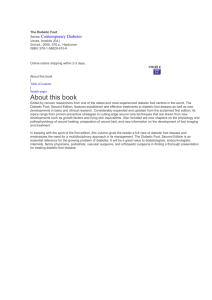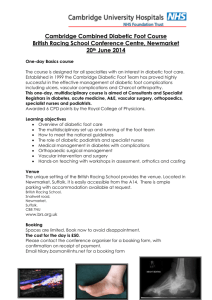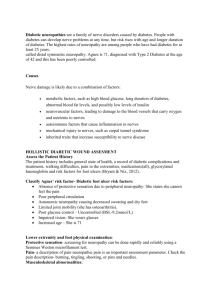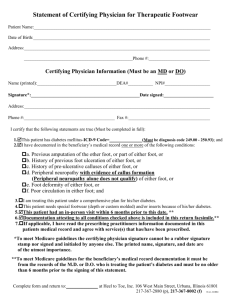a new hazard for the diabetic neuropathic footDiabetic - E
advertisement
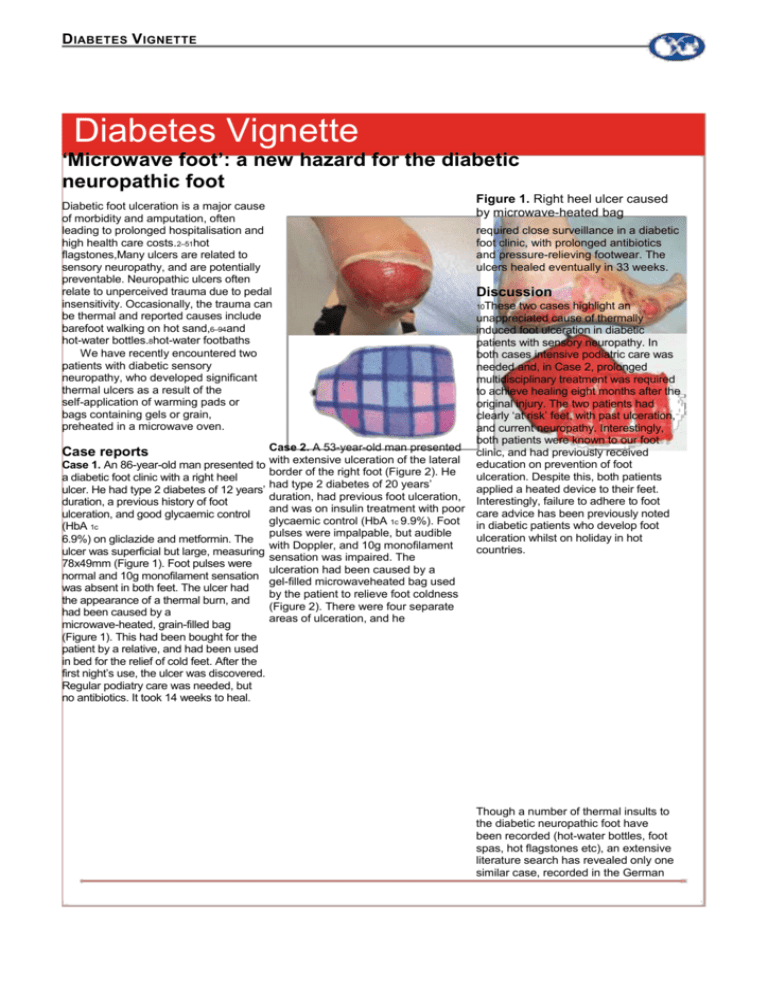
D IABETES V IGNETTE Diabetes Vignette ‘Microwave foot’: a new hazard for the diabetic neuropathic foot Diabetic foot ulceration is a major cause of morbidity and amputation, often leading to prolonged hospitalisation and high health care costs.2–51hot flagstones,Many ulcers are related to sensory neuropathy, and are potentially preventable. Neuropathic ulcers often relate to unperceived trauma due to pedal insensitivity. Occasionally, the trauma can be thermal and reported causes include barefoot walking on hot sand,6–94and hot-water bottles.8hot-water footbaths We have recently encountered two patients with diabetic sensory neuropathy, who developed significant thermal ulcers as a result of the self-application of warming pads or bags containing gels or grain, preheated in a microwave oven. Figure 1. Right heel ulcer caused by microwave-heated bag required close surveillance in a diabetic foot clinic, with prolonged antibiotics and pressure-relieving footwear. The ulcers healed eventually in 33 weeks. Discussion 10These two cases highlight an unappreciated cause of thermally induced foot ulceration in diabetic patients with sensory neuropathy. In both cases intensive podiatric care was needed and, in Case 2, prolonged multidisciplinary treatment was required to achieve healing eight months after the original injury. The two patients had clearly ‘at risk’ feet, with past ulceration, and current neuropathy. Interestingly, both patients were known to our foot Case 2. A 53-year-old man presented clinic, and had previously received Case reports Case 1. An 86-year-old man presented to with extensive ulceration of the lateral education on prevention of foot border of the right foot (Figure 2). He ulceration. Despite this, both patients a diabetic foot clinic with a right heel had type 2 diabetes of 20 years’ applied a heated device to their feet. ulcer. He had type 2 diabetes of 12 years’ duration, had previous foot ulceration, Interestingly, failure to adhere to foot duration, a previous history of foot and was on insulin treatment with poor care advice has been previously noted ulceration, and good glycaemic control glycaemic control (HbA 1c 9.9%). Foot in diabetic patients who develop foot (HbA 1c pulses were impalpable, but audible ulceration whilst on holiday in hot 6.9%) on gliclazide and metformin. The with Doppler, and 10g monofilament countries. ulcer was superficial but large, measuring sensation was impaired. The 78x49mm (Figure 1). Foot pulses were ulceration had been caused by a normal and 10g monofilament sensation gel-filled microwaveheated bag used was absent in both feet. The ulcer had by the patient to relieve foot coldness the appearance of a thermal burn, and (Figure 2). There were four separate had been caused by a areas of ulceration, and he microwave-heated, grain-filled bag (Figure 1). This had been bought for the patient by a relative, and had been used in bed for the relief of cold feet. After the first night’s use, the ulcer was discovered. Regular podiatry care was needed, but no antibiotics. It took 14 weeks to heal. Though a number of thermal insults to the diabetic neuropathic foot have been recorded (hot-water bottles, foot spas, hot flagstones etc), an extensive literature search has revealed only one similar case, recorded in the German Figure 2. Extensive ulceration resulting from microwave bag use 11literature. This concerned a diabetic patient with advanced complications and on chronic peritoneal dialysis, who used a seed-containing pad heated in a microwave oven. This was applied to a foot, resulting in extensive burns and eventual amputation. These devices offer a clear potential danger to diabetes patients with sensory neuropathy. The instructions on them areR Rowlands, Department of Podiatry SJ Benbow, D Sharma, GV Gill* often unclear, and their safe use depends on a person’s ability to feel howDepartment of Diabetes/Endocrinology hot the device has become. As All at: Aintree University Hospitals NHS microwave ovens have different levels of Foundation Trust, Liverpool, UK power, heating can also be variable *E-mail: g.gill@liv.ac.uk between machines, compounding the risk. Health professionals and patients References need to be aware of this problem, and References are available at such devices should carry a hazard www.practical diabetesinternational.com. warning for patients with diabetes. Practical Diabetes International invites you to submit your favourite slide with clinical details for possible publication in this series. 204 Pract Diab Int June 2010 Vol. 27 No. 5 Copyright © 2010 John Wiley & Sons D IABETES V IGNETTE Diabetic foot ulceration and microwave heated pads diabetic feet. Singapore Med J 1999; 40: al. ‘Diabetic holiday foot syndrome’: a preventable complication. Pract Diabetes Int 362–364. 2001; 18: 45–47. 8. Jose RM, Vidyadadharan R, Roy DK, et al. Hot 5. Morbach S, Möllenburg J, Quante C, et al. water bottles – a cautionary tale. Br J Gen Pract ‘Diabetic holiday foot syndrome’ – the dimension of2005; 55: 222–223. the problem and patients’ characteristics. Pract 9. Dijkstra S, van der Bent MJ, van der Brand HJ, Diabetes Int 2001; 18: 48–50. et al. Diabetic patients with foot burns. Diabet Med References 6. Balakrishnan C, Rak TP, Meininger MS. Burns 1997; 12: 1080–1083. of the neuropathic foot following the use of 10.Pickin R, Kaye L, Bush A, et al. Attempts to 1. Wu SC, Driver VR, Wrobel JS, et al. Foot ulcers therapeutic footbaths. Burns 1995; 21: 622–623. prevent holiday-related diabetic foot ulceration. in the diabetic patient, prevention and treatment. Pract Diabetes Int 2008; 25: 144–146. Vasc Health Risk Manag 2007; 3: 65–76. 11.Frey FJ. Microwave-induced heating injury. 2. Gaztelu Valdés V, Gago Fornells M, Garcia Ther Umsch 2004; 61: 703–706. González RF, et al. Hot sand burns on the sole of a patient with diabetes. J Wound Care 2002; 11: 170–171. 3. Schilling UM. Burning feet. MMW Fortshr Med 7. Thng P, Lim RMC, Low BY. Thermal burns in 2006; 148: 42–43. 4. Stannaway SERS, Gill GV, Kaczmarcyk E, et Pract Diab Int June 2010 Vol. 27 No. 5 Copyright © 2010 John Wiley & Sons 204a
